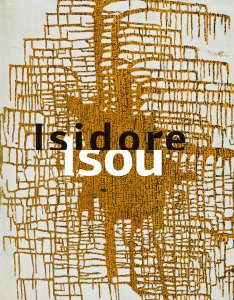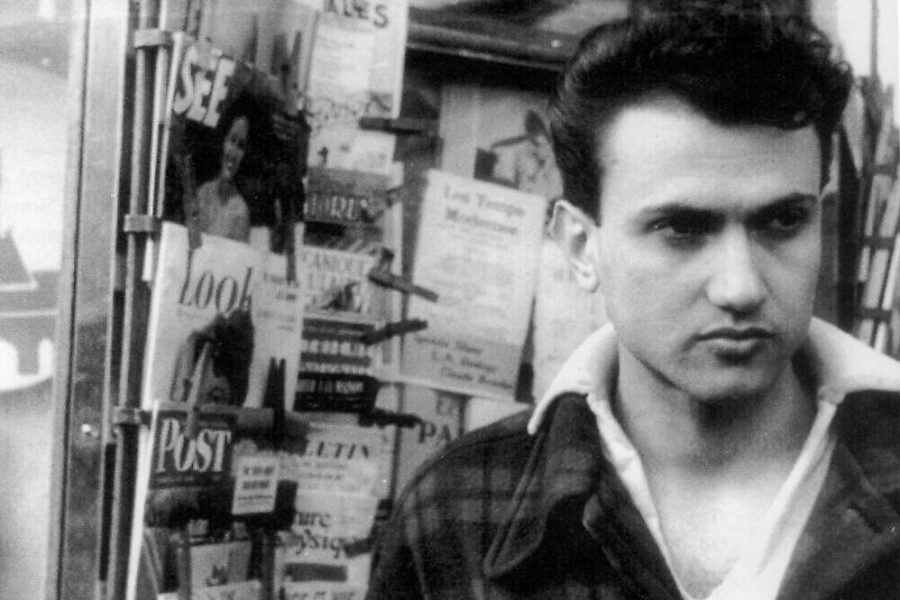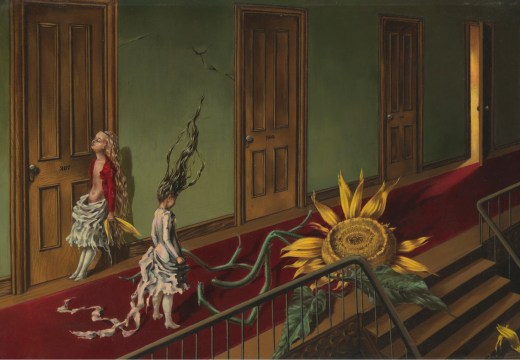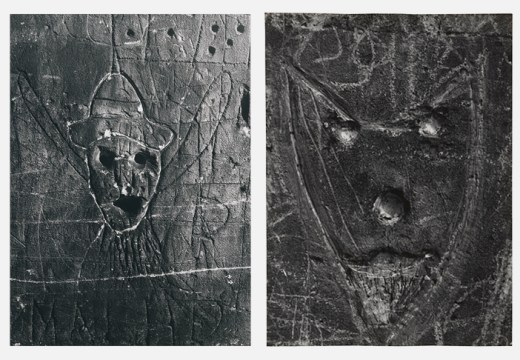This review of Isidore Isou by Frédéric Acquaviva was published in the December 2020 issue of Apollo. Preview and subscribe here.
Despite the recent retrospective at the Centre Pompidou in 2019, the work of the Franco-Romanian film-maker, poet, composer and visual artist Isidore Isou (1925–2007) is still underrated or misunderstood by many art critics, particularly in Paris. Most of these see Lettrism, the avant-garde movement Isou founded, as a museum piece, a half-forgotten relic from the post-war Left Bank, and at best a minor adjunct of Dada or Surrealism.
The series of revelations that led Isou (born Isidore Goldstein) to Lettrism came to him on 19 March 1942 in Bucharest, when he was 17 years old and read (or slightly misread) a text by the philosopher Hermann von Keyserling that prompted him to write his first manifesto declaring his belief in a ‘poesie graphique’. He eventually made his way to Paris in 1945, where his looks and charisma helped him attract a group of disciples. He also mixed in elite circles and was briefly a friend of André Gide and Jean Cocteau, but never lost his sense that he was a Romanian Jew who had escaped an apocalypse.
For the past three years, I have been writing a biography of Isou that argues for his place at the centre of the post-war avant-garde. I met him in Paris when he was 74 and I was working on a biography of the ‘Situationist’ writer Guy Debord. In the 1940s Debord and Isou had been close friends, but they had subsequently fallen out and despised each other for the rest of their lives. Given the animosity that had simmered between them for so long, I was amazed that Isou had agreed to speak to me at all. For decades Debord and his adherents had said that Isou was senile or simply mad, but as we began talking, with Isou cracking jokes, it quickly became clear that this was not so. Happily, we soon left the intricacies of avant-garde rivalry behind and instead discussed Lettrism and what it meant to be a lettriste.
Isou explained to me that Lettrism was not simply an art technique, another way of making music, film or poetry, but a revolution in consciousness. He explored this idea in his writings, most notably – and lengthily – in the book La Créatique ou la Novatique (1941–76), which was published in 2004. The title is untranslatable as these words are neologisms that are best understood as Isou develops his theory, over the course of more than a thousand pages, that societies progress not because of the human instinct for survival but because of the desire to create (‘la créatique’). More than this, if creativity is the highest form of action, and art its most visible form, then humanity is in charge of history (‘la novatique’). In this way, the artist takes the place of God, the first creator or artist.
 It is now possible to see how this philosophy took visual form in this monograph by Frédéric Acquaviva, which last year was awarded the prize for the best book on contemporary art at the Festival International du livre d’art et du film (FILAF) in Perpignan. Until now Isou’s work has been scattered among a few major museums and private collections that have been hard to trace, but Acquaviva has now brought together almost all of the major paintings and drawings, amounting to roughly 200 works.
It is now possible to see how this philosophy took visual form in this monograph by Frédéric Acquaviva, which last year was awarded the prize for the best book on contemporary art at the Festival International du livre d’art et du film (FILAF) in Perpignan. Until now Isou’s work has been scattered among a few major museums and private collections that have been hard to trace, but Acquaviva has now brought together almost all of the major paintings and drawings, amounting to roughly 200 works.
Although Acquaviva’s emphasis is on the painting rather than the life, the book follows a strict chronology. Crucially, Acquaviva, who is not a painter himself but an avant-garde composer who worked with Isou in the late 1990s, is an excellent scholarly guide to the artworks. These images, all beautifully reproduced here, demonstrate the unruly brilliance of Isou as an artist. They include, for example, Les Journaux des dieux (1950), which Isou described as the world’s first ever ‘hypergraphic’ novel – a new form of artistic expression that would take writing and thought beyond even Joyce’s Finnegans Wake (a source of constant inspiration for Isou). This hypnotic work consists of 50 plates of multicoloured text, diagrams, drawings and musical notation that forms an ‘unreadable’ but fascinating puzzle. Isou composed the book and pulled off the complicated effects it required with the help of his friend Maurice Lemaître, who used the skills he had acquired during his apprenticeship making prints in the École des Arts et Métiers. No one is quite sure how many copies were printed – not many, which explains the high prices examples can fetch. If you can find it in a rare book shop, I would argue it is worth paying whatever the dealer is asking for it.
Like the Surrealists, Isou was fascinated by theories of alchemy, and by the alchemists’ quest to turn base metals into gold and find the elixir of life; most importantly, he was attracted to the belief that everything can be transformed. This idea is Lettrism in action; it is how music becomes painting and painting becomes film and film become writing; everything is endlessly mutable.
One of the clearest examples of this is found in the 1951 film Traité de bave et d’eternité, which Isou presents as a riposte to conventional cinema. The film’s message, that ordinary men and women could themselves be creators and thus walk with God as ‘the companions of Creation’, is revealed more explicitly in Isou’s messianic voiceover that ends the film.
Acquaviva does not touch upon the philosophical side of Isou’s work and if there is a biographical flaw in this book it is that little mention is made of the Romanian Holocaust, which Isou escaped, and which was a subject he returned to in later works. Jonas, ou le Corps à la recherche de son âme (1984), for example, is an account of Isou’s suffering as an Ostjude in exile. Acquaviva does however provide a great service by simply showing us almost all of Isou’s art and explaining its context. In this way he not only restores Isou to his true place in history but helps us complete a fuller story of the Parisian avant-gardes in the 20th century.
Isidore Isou by Frédéric Acquaviva is published by Éditions du Griffon. Andrew Hussey’s biography, Speaking East: The Strange and Enchanted Life of Isidore Isou, will be published by Reaktion Books in September.
From the December 2020 issue of Apollo. Preview and subscribe here.
Unlimited access from just $16 every 3 months
Subscribe to get unlimited and exclusive access to the top art stories, interviews and exhibition reviews.














![Masterpiece [Re]discovery 2022. Photo: Ben Fisher Photography, courtesy of Masterpiece London](http://www.apollo-magazine.com/wp-content/uploads/2022/07/MPL2022_4263.jpg)
Has the Fitzwilliam got its rehang right?